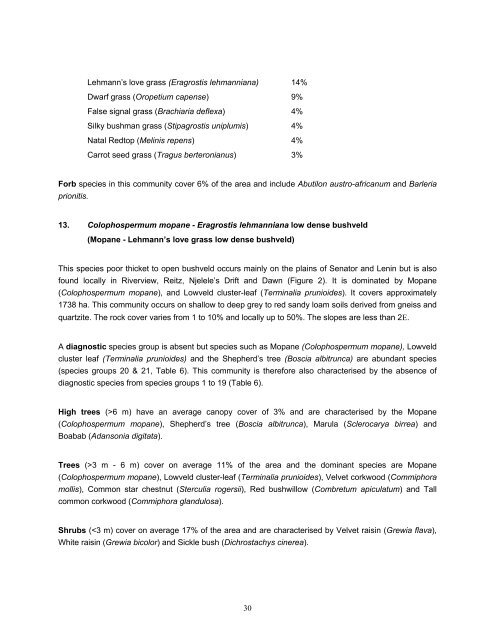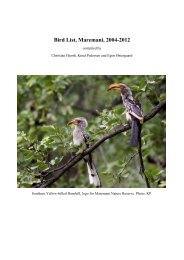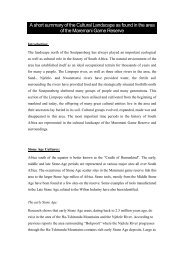the vegetation types and veld condition - Maremani Nature Reserve
the vegetation types and veld condition - Maremani Nature Reserve
the vegetation types and veld condition - Maremani Nature Reserve
Create successful ePaper yourself
Turn your PDF publications into a flip-book with our unique Google optimized e-Paper software.
Lehmann’s love grass (Eragrostis lehmanniana) 14%<br />
Dwarf grass (Oropetium capense) 9%<br />
False signal grass (Brachiaria deflexa) 4%<br />
Silky bushman grass (Stipagrostis uniplumis) 4%<br />
Natal Redtop (Melinis repens) 4%<br />
Carrot seed grass (Tragus berteronianus) 3%<br />
Forb species in this community cover 6% of <strong>the</strong> area <strong>and</strong> include Abutilon austro-africanum <strong>and</strong> Barleria<br />
prionitis.<br />
13. Colophospermum mopane - Eragrostis lehmanniana low dense bush<strong>veld</strong><br />
(Mopane - Lehmann’s love grass low dense bush<strong>veld</strong>)<br />
This species poor thicket to open bush<strong>veld</strong> occurs mainly on <strong>the</strong> plains of Senator <strong>and</strong> Lenin but is also<br />
found locally in Riverview, Reitz, Njelele’s Drift <strong>and</strong> Dawn (Figure 2). It is dominated by Mopane<br />
(Colophospermum mopane), <strong>and</strong> Low<strong>veld</strong> cluster-leaf (Terminalia prunioides). It covers approximately<br />
1738 ha. This community occurs on shallow to deep grey to red s<strong>and</strong>y loam soils derived from gneiss <strong>and</strong><br />
quartzite. The rock cover varies from 1 to 10% <strong>and</strong> locally up to 50%. The slopes are less than 2Ε.<br />
A diagnostic species group is absent but species such as Mopane (Colophospermum mopane), Low<strong>veld</strong><br />
cluster leaf (Terminalia prunioides) <strong>and</strong> <strong>the</strong> Shepherd’s tree (Boscia albitrunca) are abundant species<br />
(species groups 20 & 21, Table 6). This community is <strong>the</strong>refore also characterised by <strong>the</strong> absence of<br />
diagnostic species from species groups 1 to 19 (Table 6).<br />
High trees (>6 m) have an average canopy cover of 3% <strong>and</strong> are characterised by <strong>the</strong> Mopane<br />
(Colophospermum mopane), Shepherd’s tree (Boscia albitrunca), Marula (Sclerocarya birrea) <strong>and</strong><br />
Boabab (Adansonia digitata).<br />
Trees (>3 m - 6 m) cover on average 11% of <strong>the</strong> area <strong>and</strong> <strong>the</strong> dominant species are Mopane<br />
(Colophospermum mopane), Low<strong>veld</strong> cluster-leaf (Terminalia prunioides), Velvet corkwood (Commiphora<br />
mollis), Common star chestnut (Sterculia rogersii), Red bushwillow (Combretum apiculatum) <strong>and</strong> Tall<br />
common corkwood (Commiphora gl<strong>and</strong>ulosa).<br />
Shrubs (




